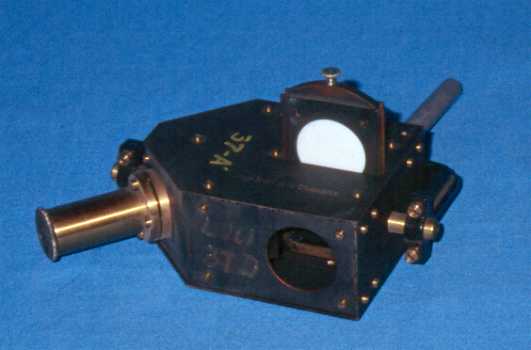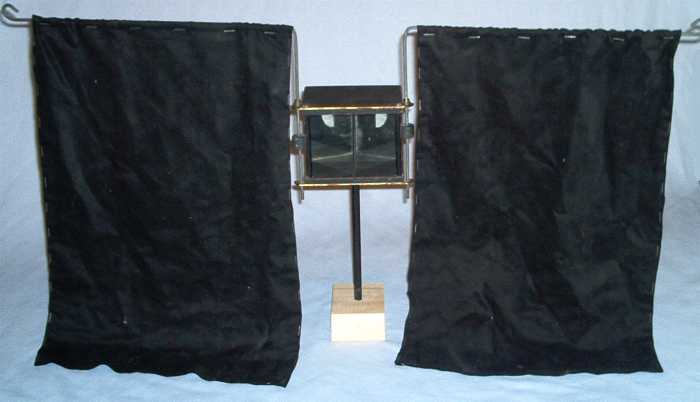Photometer
Photometers are used to measure the intensity of the light produced
by an unknown source in terms of a standard source. The general technique
is to locate the two sources so that they give the same illumination to two
adjacent surfaces. If we assume that the sources are small compared to the
distance from them to the illuminated surfaces, the inverse square law may
be used. That is, the intensity of the unknown at a distance x from
the surfaces is related to the intensity I(0) of the standard source
a distance s from the surfaces by I = I(0) (x/s)².
The standard source was the English standard candle, which
was made of spermaceti, a wax obtained from sperm whale oil, consumed at
a rate of 7.776 grams per hour with a flame height of 4.5 cm. The diameter
of the candle was 2.22 cm.
The photometer below was invented by Charles Wheatstone (1802-1875).
It originally had a glass bead stuck to the piece of putty in the upper
right-hand corner. When the ivory handle on the crank was turned, the internal
and external gearing made the bead travel in the rosette-pattern shown on
the left, with each of the lights leaving a trail behind due to the persistence
of vision. The distances to the two sources was adjusted until the eye saw
equal brightness in each path. This one is unmarked, but a similar device
was sold by Max Kohl of Chemnitz about 1900 at 33 marks.
| The example of Wheatstone's photometer at
the right is in the Millington/Barnard Collection in the University Museum
at the University of Mississippi.
It was probably bought by Prof. F.A.P. Bardnard in
the second half of the 1850s from the firm of Lerebour's et Secretan of
Paris. In the 1853 L&S catalogue it is listed at 30 francs, or about
$6.
|

|
The photometer below, in the Kenyon College collection, is
of the Lummer and Brodhun style, and was made by Max Kohl. Otto Lummer and
Eugen Lummer of the Physikalish-Technische-Reichanstalt in Berlin developed
the instrument in 1889. In this design, the user looked through the eyepiece
and, due to internal beamsplitters and mirrors, was able to see the images
of both sides of the illuminated disk at the same time and thus compare them.
Photometers of this type are still in use today. This instrument cost 125
marks in 1900.

The grease-spot type photometer below is a humbler version of the Lummer-Brodhum
photometer described above. The standard candle is placed in one end compartment,
and the unknown light source was placed in the other. The chimneys allow
the heated air from the light sources to be vented upward. The grease spot
is actually a piece of translucent paper mounted on a sliding carriage that
can be seen in the long opened compartment on the left-hand side. A pair
of tilted mirrors allows both sides of the spot to be seen by the observer
-- one image can be seen clearly on the right-hand mirror. The carriage is
moved back and forth until the spot appears to have the same illumination
as the background paper. The position of the carriage is then read from the
meter stick running the length of the apparatus and the inverse square law
is used to find the relative intensity of the unknown. This apparatus is
about four feet in length, and is in the Greenslade Collection. The style
of label and its lack of appearance in 1920 through 1950 catalogues suggests
that it is pre-1920.


|
The photometer head at the left is designed
to be used in a dimly lighted room. The inclined mirrors show the piece of
paper with the grease spot that is illuminated from the right and the left
by the known and unknown light sources. The system could be held on an optical
bench. The curtains swing forward and keep the observer from being distracted
by the direct light from the two sources.
This unmarked device probably dates from the nineteen twenties
and is in the Greenslade Collection.
|
REF: Thomas B. Greenslade, Jr., "Two Photometers", Phys. Teach.,
15, 44-45 (1977)
Return to Optics Home Page
| Return to Home Page